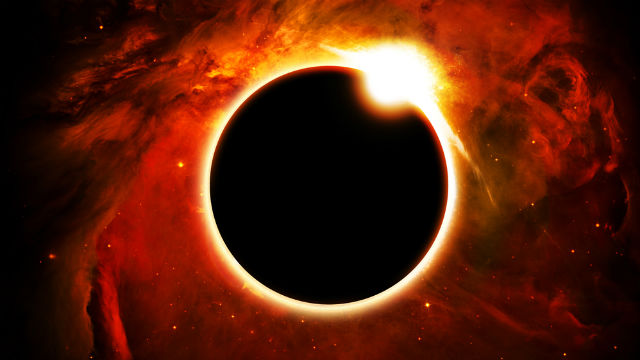Messier Monday: An Elliptical Rotating Wrongly, M59
There’s no wrong way to be a galaxy, but this one sure does challenge our expectations.
“Fantasy is a necessary ingredient in living, it’s a way of looking at life through the wrong end of a telescope. Which is what I do, and that enables you to laugh at life’s realities.” –Dr. Seuss
On the night of a new Moon, there’s no better time to go hunting for galaxies at any location with dark skies. Of all the 110 Messier objects — deep-sky fixtures from our galaxy and beyond — a full 40 of them are galaxies. In general, galaxies can be spirals or ellipticals, but these can be further classified into dwarfs, lenticulars and barred spirals.

Only six of the Messier objects are true giant ellipticals, and today’s object, Messier 59, is perhaps the most unusual of them all. Not because of its location, mind you; it’s located deep within the Virgo cluster, where all of Messier’s ellipticals except last week’s entry can be found. Here’s how to locate it for yourself.

Clearly visible from the northern hemisphere, the Big Dipper is perhaps the most recognizable sight in the night sky, with the prominent constellation of Leo shining brightly beneath the dipper’s cup. If you draw an imaginary line from Leo’s brightest star through it’s second brightest — from Regulus to Denebola — you’ll come to Vindemiatrix, the brightest star for about 10° in any direction.
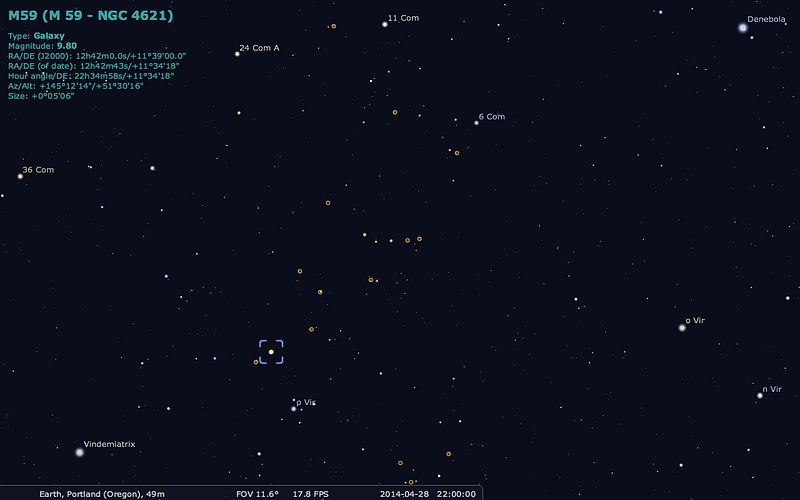
Look in between Vindemiatrix and Denebola if you will: you’ll see four stars (labelled above) in a “kite” formation. Many galaxies of the Virgo Cluster — the nearest cluster of 1000+ galaxies to us — can be found in there, including today’s object, Messier 59. To get there, locate the bottom star of the kite: ρ Virginis, easily visible from most suburban (and darker) skies with the naked eye.
If you can drop a perpendicular line from ρ Virginis to the imaginary line that connects Vindemiatrix to Denebola, Messier 59 will be the faint, fuzzy isolated sight that awaits you at that intersection.
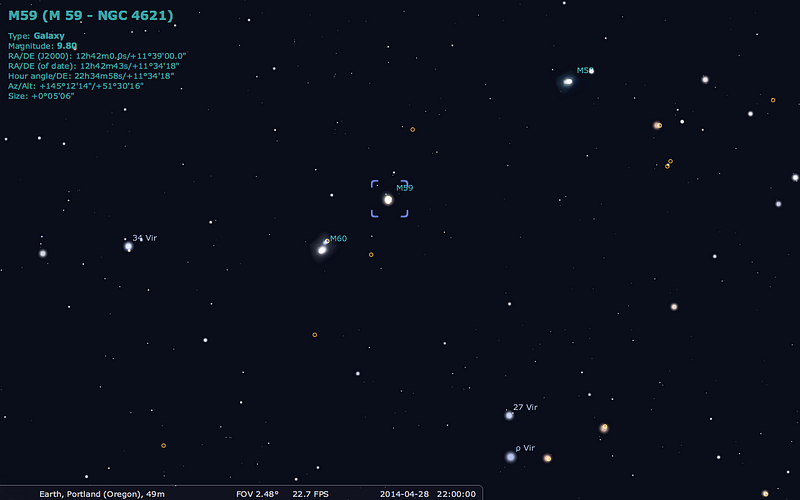
Through even a modest, small telescope, it’s visible as a bright central core that gradually dims out as you move away from the center, located very close to another of Messier’s ellipticals: M60. It was first observed by Messier just four days after its discovery — by Johann Koehler — on April 15th, 1779. His description was as follows:
Nebula in Virgo & in the neighborhood of the preceding, on the parallel of epsilon [Virginis], which has served for its determination: it is of the same light as the above, equally faint.
To Messier’s instruments, it might have looked something like this.
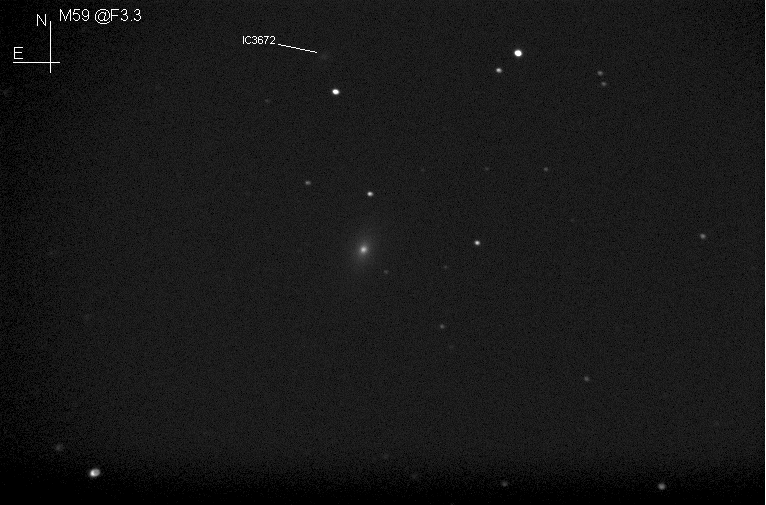
Indistinct, faint and nebulous above all else, this is, in fact, one of the most massive objects in the entire Virgo Cluster, coming in only behind M49, M60 and the giant M87. But unlike the other giant ellipticals, Messier 59 is much longer in one direction than the other: it’s very non-spherical and truly ellipsoidal!
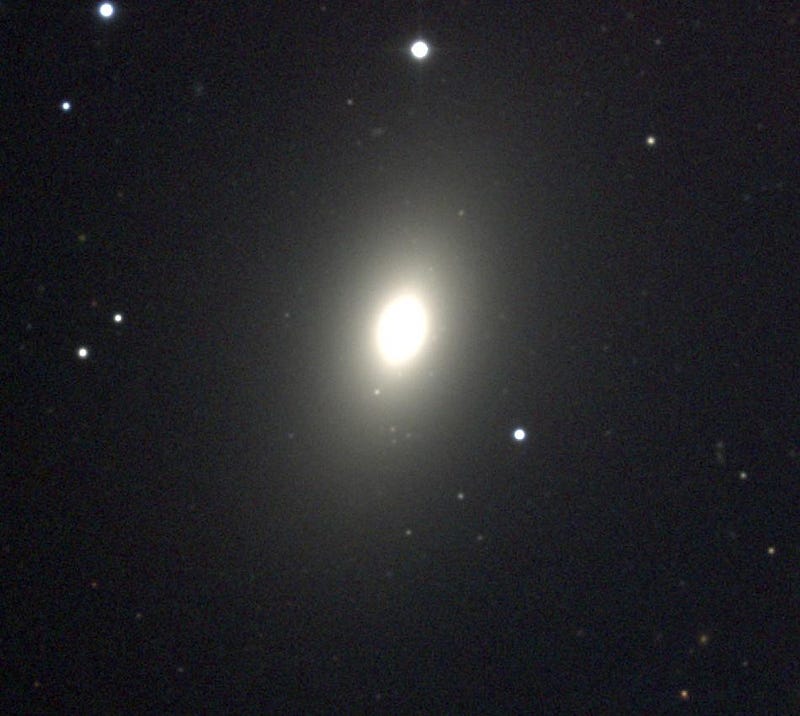
Like many giant ellipticals, it’s found in a dense cluster of many galaxies and is likely the result of many major mergers. It contains little neutral gas or dust, has thousands of globular clusters (compared to just 150-200 or so for the Milky Way), and — as a look in the infrared reveals — has practically no new regions of star formation or hot, blue stars!
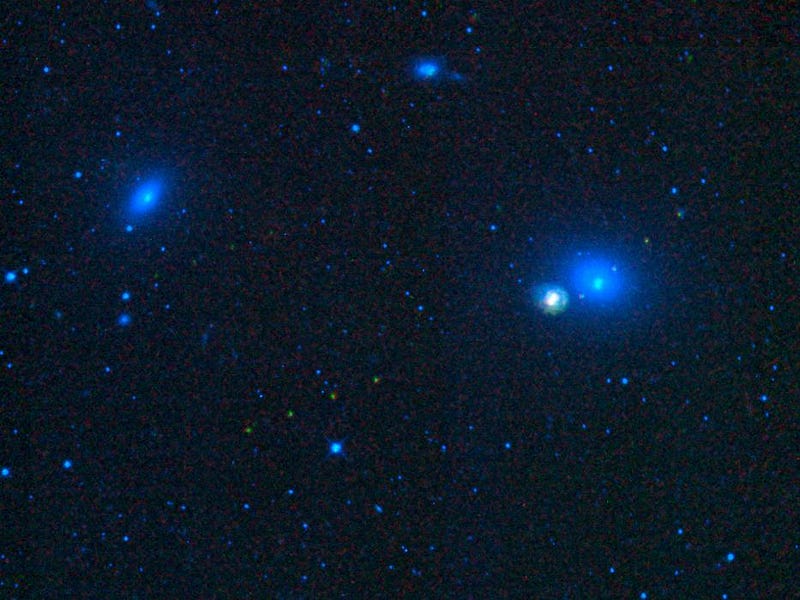
What it also has in common with many giant ellipticals is a huge black hole at its center. There’s obviously something interesting happening at the core, because it’s extremely bright in the infrared and the visible, and yet has no hot, young stars in there.
But things really get interesting if we start examining the motions of stars in this innermost region of M59.
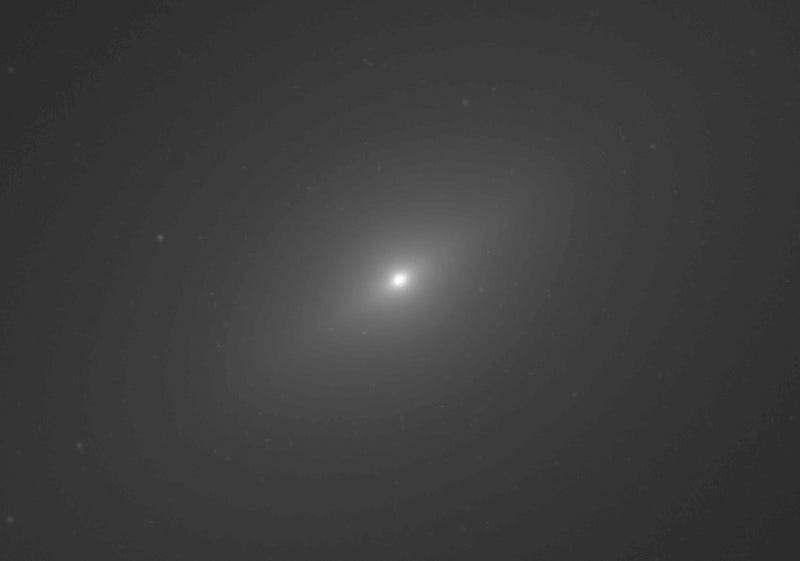
Can you see a disk-like feature in there? (Maybe if you squint?) This inner region has stars that are rotating in the opposite direction from the rest of the galaxy, a super bizarre phenomenon.
What could be causing it? Have a look at the X-ray (from Chandra, on the left) next to the visible light image (from SDSS, on the right) below.
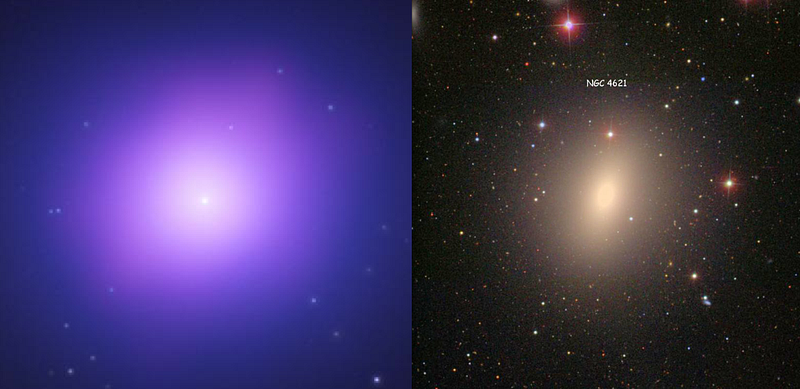
The innermost 200 light-years or so must be counterrotating, the smallest region in a galaxy ever observed to do so! Incredibly, the mass of the black hole required to cause these X-ray and gravitational effects must be a whopping 270 million Solar masses, nearly 100 times as massive as the Milky Way’s black hole.
There are also central outflows coming off of this galaxy, and this was one of the key galaxies in discovering the connection between central black holes and how giant galaxies form-and-evolve!
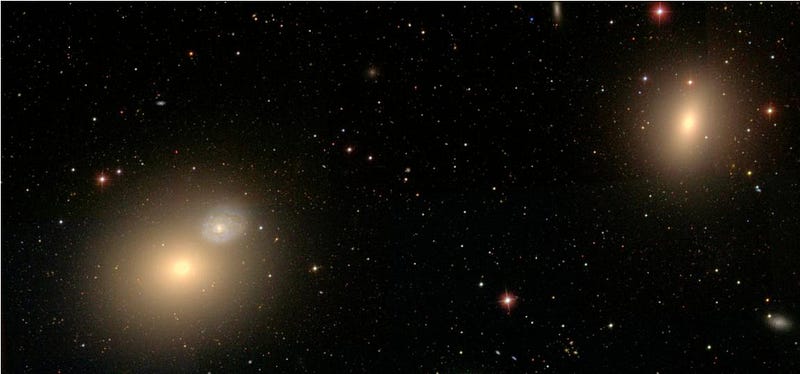
The Sloan Digital Sky Survey has my favorite wide-field image of this galaxy,

while the Hubble Space Telescope provides an outstanding view of just how much brighter this galaxy’s core region is than the rest of the galaxy itself.
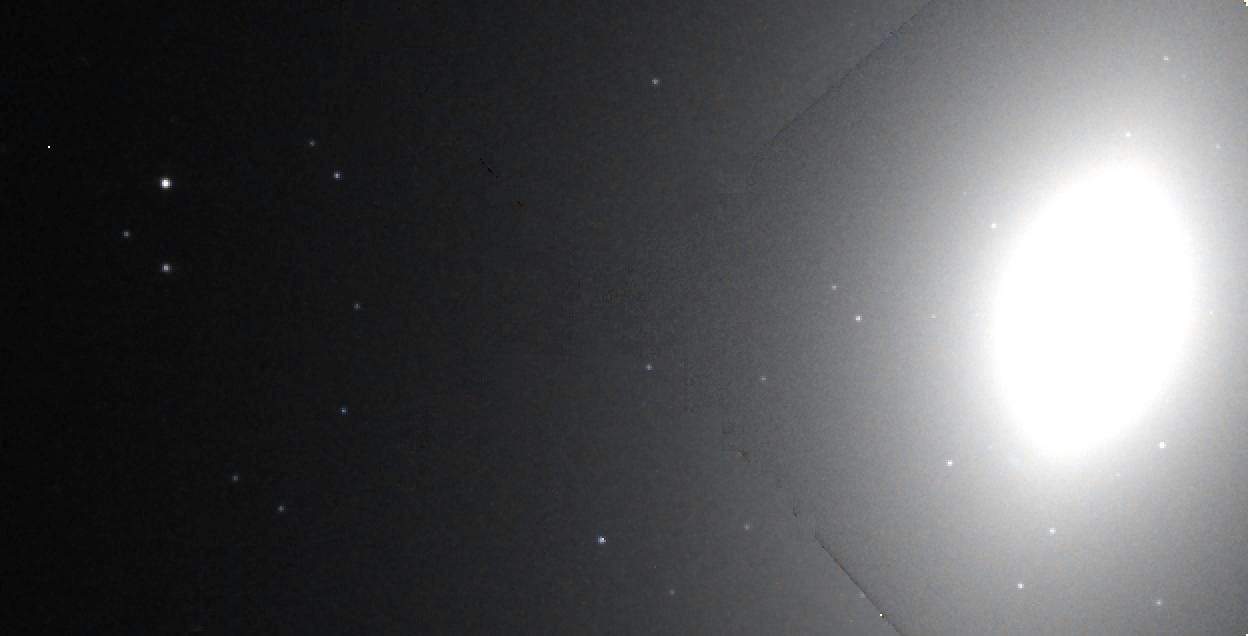
Of all the galaxies in Virgo, Messier 59 is home to the very first supernova ever detected as it went off in one: all the way back in 1939. (M87’s supernova in 1919 wasn’t detected until three years after-the-fact!) Amazingly, since that 1939 event, that galaxy has gone 85 years without another one!
And with that remarkable fact, we come to the end of another Messier Monday. Including today’s object, we’ve examined:
- M1, The Crab Nebula: October 22, 2012
- M2, Messier’s First Globular Cluster: June 17, 2013
- M3, Messier’s First Original Discovery: February 17, 2014
- M5, A Hyper-Smooth Globular Cluster: May 20, 2013
- M7, The Most Southerly Messier Object: July 8, 2013
- M8, The Lagoon Nebula: November 5, 2012
- M11, The Wild Duck Cluster: September 9, 2013
- M12, The Top-Heavy Gumball Globular: August 26, 2013
- M13, The Great Globular Cluster in Hercules: December 31, 2012
- M15, An Ancient Globular Cluster: November 12, 2012
- M18, A Well-Hidden, Young Star Cluster: August 5, 2013
- M20, The Youngest Star-Forming Region, The Trifid Nebula: May 6, 2013
- M21, A Baby Open Cluster in the Galactic Plane: June 24, 2013
- M25, A Dusty Open Cluster for Everyone: April 8, 2013
- M29, A Young Open Cluster in the Summer Triangle: June 3, 2013
- M30, A Straggling Globular Cluster: November 26, 2012
- M31, Andromeda, the Object that Opened Up the Universe: September 2, 2013
- M32, The Smallest Messier Galaxy: November 4, 2013
- M33, The Triangulum Galaxy: February 25, 2013
- M34, A Bright, Close Delight of the Winter Skies: October 14, 2013
- M36, A High-Flying Cluster in the Winter Skies: November 18, 2013
- M37, A Rich Open Star Cluster: December 3, 2012
- M38, A Real-Life Pi-in-the-Sky Cluster: April 29, 2013
- M39, The Closest Messier Original: November 11, 2013
- M40, Messier’s Greatest Mistake: April 1, 2013
- M41, The Dog Star’s Secret Neighbor: January 7, 2013
- M42, The Great Orion Nebula: February 3, 2014
- M44, The Beehive Cluster / Praesepe: December 24, 2012
- M45, The Pleiades: October 29, 2012
- M46, The ‘Little Sister’ Cluster: December 23, 2013
- M47, A Big, Blue, Bright Baby Cluster: December 16, 2013
- M48, A Lost-and-Found Star Cluster: February 11, 2013
- M49, Virgo’s Brightest Galaxy: March 3, 2014
- M50, Brilliant Stars for a Winter’s Night: December 2, 2013
- M51, The Whirlpool Galaxy: April 15th, 2013
- M52, A Star Cluster on the Bubble: March 4, 2013
- M53, The Most Northern Galactic Globular: February 18, 2013
- M56, The Methuselah of Messier Objects: August 12, 2013
- M57, The Ring Nebula: July 1, 2013
- M58, The Farthest Messier Object (for now): April 7, 2014
- M59, An Elliptical Rotating Wrongly: April 28, 2014
- M60, The Gateway Galaxy to Virgo: February 4, 2013
- M61, A Star-Forming Spiral: April 14, 2014
- M63, The Sunflower Galaxy: January 6, 2014
- M64, The Black Eye Galaxy: February 24, 2014
- M65, The First Messier Supernova of 2013: March 25, 2013
- M66, The King of the Leo Triplet: January 27, 2014
- M67, Messier’s Oldest Open Cluster: January 14, 2013
- M68, The Wrong-Way Globular Cluster: March 17, 2014
- M71, A Very Unusual Globular Cluster: July 15, 2013
- M72, A Diffuse, Distant Globular at the End-of-the-Marathon: March 18, 2013
- M73, A Four-Star Controversy Resolved: October 21, 2013
- M74, The Phantom Galaxy at the Beginning-of-the-Marathon: March 11, 2013
- M75, The Most Concentrated Messier Globular: September 23, 2013
- M77, A Secretly Active Spiral Galaxy: October 7, 2013
- M78, A Reflection Nebula: December 10, 2012
- M79, A Cluster Beyond Our Galaxy: November 25, 2013
- M81, Bode’s Galaxy: November 19, 2012
- M82, The Cigar Galaxy: May 13, 2013
- M83, The Southern Pinwheel Galaxy, January 21, 2013
- M85, The Most Northern Member of the Virgo Cluster, February 10, 2014
- M86, The Most Blueshifted Messier Object, June 10, 2013
- M87, The Biggest One of them All, March 31, 2014
- M88, A Perfectly Calm Spiral in a Gravitational Storm, March 24, 2014
- M92, The Second Greatest Globular in Hercules, April 22, 2013
- M93, Messier’s Last Original Open Cluster, January 13, 2014
- M94, A double-ringed mystery galaxy, August 19, 2013
- M95, A Barred Spiral Eye Gazing At Us, January 20, 2014
- M96, A Galactic Highlight to Ring in the New Year, December 30, 2013
- M97, The Owl Nebula, January 28, 2013
- M98, A Spiral Sliver Headed Our Way, March 10, 2014
- M99, The Great Pinwheel of Virgo, July 29, 2013
- M101, The Pinwheel Galaxy, October 28, 2013
- M102, A Great Galactic Controversy: December 17, 2012
- M103, The Last ‘Original’ Object: September 16, 2013
- M104, The Sombrero Galaxy: May 27, 2013
- M105, A Most Unusual Elliptical: April 21, 2014
- M106, A Spiral with an Active Black Hole: December 9, 2013
- M108, A Galactic Sliver in the Big Dipper: July 22, 2013
- M109, The Farthest Messier Spiral: September 30, 2013
Thanks for joining me today, and enjoy your dark, new-Moon skies tonight!
Have a comment? Weigh in at the Starts With A Bang forum on Scienceblogs!





